
12-01-2026 22:02
Ethan CrensonHello all, I am hoping someone will have some ins

11-01-2026 20:35
Hello.A very tiny pyrenomycete sprouting sparsely

12-01-2026 05:24
 Danny Newman
Danny Newman
Cyathicula coronata on Urtica dioicaCataloochee Di

15-12-2025 11:49
 Danny Newman
Danny Newman
ITS sequences from the following two collections B

09-01-2026 17:41
Arnold BüschlenHallo, F. dilatata wird von vielen Bryoparasiten

10-01-2026 20:00
Tom SchrierHi all,We found picnidia on Protoparmeliopsis mur

07-01-2026 22:22
 Danny Newman
Danny Newman
Tatraea sp. on indet. hardwood The Swag, Great Sm

10-01-2026 01:18
 Danny Newman
Danny Newman
cf. Neovaginatispora fuckelii on indet. shrub Pre

07-01-2026 10:24
 Danny Newman
Danny Newman
Pezicula sp. on indet. hardwood Appalachian Highl

09-01-2026 10:08
 Blasco Rafael
Blasco Rafael
Hola, en el mismo habitat que la anteriorRetamaDia
On Phytolacca old stem
Elsa Sousa,
06-12-2018 00:02
I need your sharp eyes on this ascos.
Spores mesuring:
(18.3) 20.4 - 27.3 (30.1) × (6.1) 6.5 - 8.2 (9.3) µm
Q = (2.1) 2.7 - 4 (4.4) ; N = 70
Me = 23.7 × 7.4 µm ; Qe = 3.2
2 big guttules, with a 1 septa (?). some with smaller aditional guttules on tops.
asci 118.2 × 19.2 µm inamyloid
Paraphyses on first observation with refractive tips.
More photos here https://mushroomobserver.org/349254
Would apreciate any ideas.
Thank you very much.
Hans-Otto Baral,
06-12-2018 08:25

Re : On Phytolacca old stem
Wonderful collection in good development! regrettably your equipment is too bad...
The paraphyses contain VBs whch could point to a Calycina. But with such big spores and asci?!
The spores look non-septate, otherwise the two big drops would be more close in the middle.
Could you please give the apothecial size?
Zotto
The paraphyses contain VBs whch could point to a Calycina. But with such big spores and asci?!
The spores look non-septate, otherwise the two big drops would be more close in the middle.
Could you please give the apothecial size?
Zotto
Elsa Sousa,
06-12-2018 20:36
Re : On Phytolacca old stem
Hi Zotto,
Thank you for helping with such a terrible means, but that's what my wallet can afford by now.
Apothecia are pink and the larger have about 0.9 mm.
Asci with "crochet".
Elsa
Thank you for helping with such a terrible means, but that's what my wallet can afford by now.
Apothecia are pink and the larger have about 0.9 mm.
Asci with "crochet".
Elsa
Lothar Krieglsteiner,
06-12-2018 22:16

Re : On Phytolacca old stem
Hi Elsa,
the apos are pink? So - perhaps an Ombrophila?
Greetings, Lothar
Hans-Otto Baral,
06-12-2018 22:33

Re : On Phytolacca old stem
Indeed, we know little about the excipular structure.
Elsa Sousa,
06-12-2018 22:38
Re : On Phytolacca old stem
Hi Lothar,
Let me correct, they are pinkish under scope (light pink for my surprise); scurfy like Calycina pictures, but... at naked eye, they are very tiny and I thought they were yellowish. I thought it wouldn't worth a while scoping those, because I wouldn't see anything with my poor microscope, but I was wrong.
So, I looked for Calycina... the only one macro similar ascomycete that I found, but the spores are too large...so I decided to upload here.
I'm uploading Iodine reaction. I could only see one tip reacting, so I considered inamyloid, but it could be faintly amyloid.
Thank you.
Elsa
Let me correct, they are pinkish under scope (light pink for my surprise); scurfy like Calycina pictures, but... at naked eye, they are very tiny and I thought they were yellowish. I thought it wouldn't worth a while scoping those, because I wouldn't see anything with my poor microscope, but I was wrong.
So, I looked for Calycina... the only one macro similar ascomycete that I found, but the spores are too large...so I decided to upload here.
I'm uploading Iodine reaction. I could only see one tip reacting, so I considered inamyloid, but it could be faintly amyloid.
Thank you.
Elsa
Hans-Otto Baral,
06-12-2018 23:00

Re : On Phytolacca old stem
Difficult to say. You used Lugol? Maybe your Lugol is too diluted? One must see the yellow to reddish stain to the plasma to be sure.
Did you mount directly in your Lugol to get the maximum concentration?
Did you mount directly in your Lugol to get the maximum concentration?
Elsa Sousa,
07-12-2018 00:03
Re : On Phytolacca old stem
Dear Zotto,
First 2 essays I diluted my 10% Iodine solution a bit, some minutes ago I repeated with pure solution and I can't see any change in any of the ascos (only a faintly general blueing), however, there's always a possibility of the solution being old, so... I have to try it with something really amyloid, that I haven't now.
Elsa
First 2 essays I diluted my 10% Iodine solution a bit, some minutes ago I repeated with pure solution and I can't see any change in any of the ascos (only a faintly general blueing), however, there's always a possibility of the solution being old, so... I have to try it with something really amyloid, that I haven't now.
Elsa
Hans-Otto Baral,
07-12-2018 10:07

Re : On Phytolacca old stem
10% iodine is impossible, 1% is already a strong solution and requires presence of KI, in water alone you get only maybe 0.2% I2 into solution.
In Melzer's I don't know how much iodine is soluble, but the usual concentration is around 0.5-1% I2.
In both IKI and MLZ the solution is dark red-brown when viewed in a small glass bottle, see under www.in-vivo-veritas.de -- articles -- iodine reaction (last photo).
In Melzer's I don't know how much iodine is soluble, but the usual concentration is around 0.5-1% I2.
In both IKI and MLZ the solution is dark red-brown when viewed in a small glass bottle, see under www.in-vivo-veritas.de -- articles -- iodine reaction (last photo).
Elsa Sousa,
11-12-2018 23:24
Re : On Phytolacca old stem
Zotto, Sorry.. I have been busy.
1. I use iodovinilpirrolidona used in desinfection, known by Betadine, or in this case Braunol. The container says 10% available iodine. That's why I'm used to dilute it. I know it's an old product, so I had to test with something amyloid (it always reacted with this solution - i dilute just a bit when I'm mounting the fungus).
2. I found thid Peziza this weekend, I tested with pure solution (diluted too, reaction can be seen) uploaded picture shows reaction. I tested a Otidea and got no reaction. The product must be weak.
3. Ectal excipulum of this fungus is "intricata".
4. The dead spores end up 1-septate.
Thank you.
Elsa
Hans-Otto Baral,
12-12-2018 08:11

Re : On Phytolacca old stem
Never heard of such an iodine solution, I only now the name Polyvinylpyrrolidin.
Be careful with septa: I suppose this is not a septum but results from the nucleus when the two halfs of the sporoplasm and their ol drops form two confluent bodies, leaving the middle free.
Be careful with septa: I suppose this is not a septum but results from the nucleus when the two halfs of the sporoplasm and their ol drops form two confluent bodies, leaving the middle free.

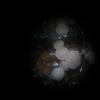
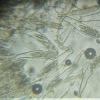

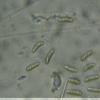
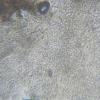
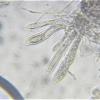
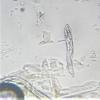
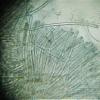
 IMGP0038-2--0001.JPG
IMGP0038-2--0001.JPG